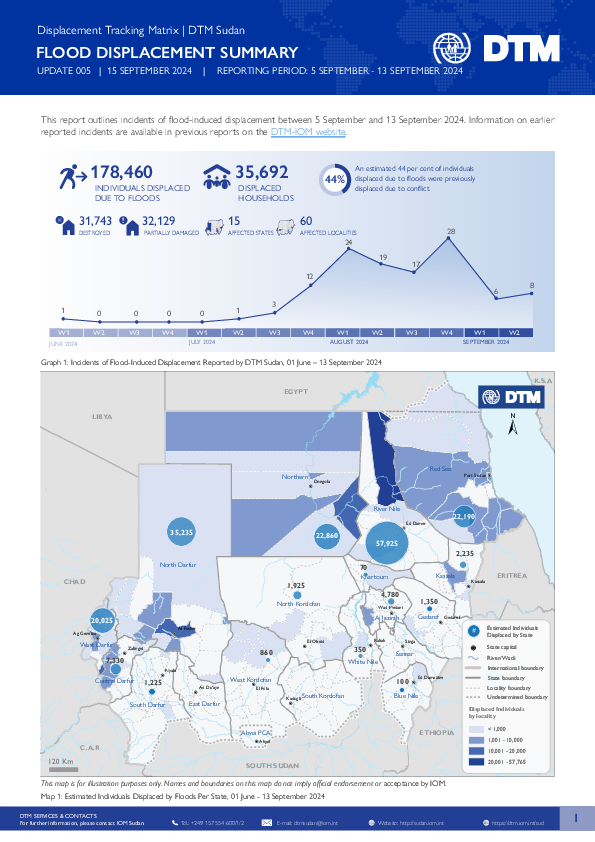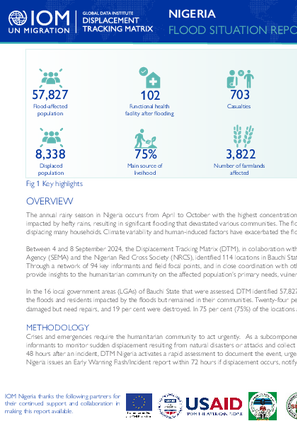-
Countries
-
Data and Analysis
-
Special Focus
-
Crisis Responses
Internal displacement
Domain host
displacement.iom.int

Contact
DTM Burundi, DTMBurundi@iom.int
Language
English
Location
Global
Period Covered
Dec 01 2022
Jun 29 2024
Activity
- Other
Since June 2022, the International Organization for Migration (IOM) Displacement Tracking Matrix (DTM) and the Joint IDP Profiling Service (JIPS) have been collaborating on the ECHO-funded project titled “Environmental Degradation and Displacement: Leveraging Citizen-Centered Data to Enhance Humanitarian Programming.” This initiative aims to address the growing challenge of displacement driven by environmental factors. To address this, IOM and JIPS are spearheading a Collective Intelligence (CI) initiative focused on Disaster Displacement and Anticipatory Action, particularly in Humanitarian Implementation Plan (HIP) priority areas in the East and Horn of Africa. The study’s findings will contribute to strengthening early warning systems already operational in Burundi.
Collective Intelligence to Address Environmental Degradation and Displacement
Collective Intelligence can be understood as the enhanced capability that emerges when groups of people work together, pooling their knowledge, skills, and insights to solve problems and make decisions more effectively than individuals working alone (UNDP, 2021). Using analytical tools to process and synthesise this information, CI can reveal patterns and insights that might not be evident otherwise and ensures that solutions and decisions reflect the collective input of the group, creating effective and inclusive outcomes.
Collective Intelligence Project
The project, as described below, included Community Consultations in nine collines with 115 Focus Group Discussions (FGDs) participants (51% male, 49% female). Data collection using the CI tool covered 65 collines in six communes across four provinces in Burundi, three of which border Lake Tanaganyika, which included 3,373 survey respondents (59% male, 42% female). Throughout the project 2,520 incidences of damage or impacts of weather-related disasters as well as 2,311 prevention and mitigation measures were mapped. The project closed with Community Validation Sessions held in nine collines with 144 FGD participants (52% male, 48% female). This case study can be used to replicate this CI approach in other regions facing similar challenges. As such, this approach will contribute to global efforts in disaster risk reduction (DRR) and enhance community resilience, demonstrating how leveraging the collective knowledge of affected populations can lead to sustainable and impactful solutions.
If you’ve had the chance to read or use this case study, please fill out a short survey in English (link here) or French (link here). We greatly appreciate your feedback.

Contact
DTM Mozambique, DTMMozambique@iom.int
Language
English
Location
Mozambique
Period Covered
May 15 2024
Jun 15 2024
Activity
- Mobility Tracking
This summary presents findings of Mobility Tracking Assessments round 21 (previously known as Baseline Assessments) conducted across Central and Southern Mozambique through key-informant and group interviews at location level between May and June 2024. Mobility Tracking assessments provides a geographical overview of demographic and mobility profiles of internally displaced persons (IDPs) and returnees across Mozambique. During this round, IOM DTM mapped a total of 28,116 households hosting 139,333 IDPs in 107 locations. Ninety eight per cent of the IDPs were identified in 93 displacement sites whilst two per cent are living in host communities. The period of displacement being considered spans from 2017 to 2024 and 99 per cent of the displacements were due to climatic conditions. Sofala hosts 64 per cent of the overall IDP figure followed by Manica (20%). Comparing to the previous round, there is a 10 per cent increase in the number of IDPs in Central attributable to widened coverage and recent drought related displacements in Manica province.

Contact
DTM Mozambique, DTMMozambique@iom.int
Language
English
Location
Mozambique
Period Covered
May 15 2024
Jun 15 2024
Activity
- Mobility Tracking
This summary presents findings of Mobility Tracking Assessments round 21 (previously known as Baseline Assessments) conducted across Central and Southern Mozambique through key-informant and group interviews at location level between May and June 2024. Mobility Tracking assessments provides a geographical overview of demographic and mobility profiles of internally displaced persons (IDPs) and returnees across Mozambique. During this round, IOM DTM mapped a total of 28,116 households hosting 139,333 IDPs in 107 locations. Ninety eight per cent of the IDPs were identified in 93 displacement sites whilst two per cent are living in host communities. The period of displacement being considered spans from 2017 to 2024 and 99 per cent of the displacements were due to climatic conditions. Sofala hosts 64 per cent of the overall IDP figure followed by Manica (20%). Comparing to the previous round, there is a 10 per cent increase in the number of IDPs in Central attributable to widened coverage and recent drought related displacements in Manica province.

Contact
DTM Sudan; dtmsudan@iom.int
Language
English
Location
Sudan
Period Covered
Sep 05 2024
Sep 13 2024
Activity
- Mobility Tracking
- Event Tracking
The Flood Displacement Summary summarizes DTM updates on incidents of flood-induced displacement across Sudan.
Between 01 June and 13 September 2024, DTM Sudan reported 119 incidents of heavy rain and floods that triggered sudden displacement in Sudan. Rain and floods displaced an estimated 178,460 individuals (35,692 households) from locations across 15 different states in Sudan.
This report outlines incidents of flood-induced displacement between 05 September and 13 September 2024. Further information on earlier reported incidents is available on the DTM-IOM Sudan website.
Highlights
- DTM observed eight incidents of flood-induced displacement between 05 September and 13 September 2024.
- These reported incidents triggered the displacement of an estimated 5,940 individuals (1,188 households).
- Approximately 1,349 structures were either destroyed or partially damaged due to rain or floods.
- An estimated 44 per cent of individuals displaced due to floods were already displaced due to conflict prior to the onset of floods.

Contact
dtmhaiti@iom.int
Language
English
Location
Haiti
Period Covered
Sep 10 2024
Sep 13 2024
Activity
- Mobility Tracking
- Event Tracking
This information was collected following armed clashes in the neighborhoods of Boston in the municipality of Cité Soleil, which occurred on 11
September 2024 and in the neighborhood of 2nd Cité Saint Martin in the municipality of Delmas, on 10 September 2024. A total of 2,327
individuals were displaced as a result of these clashes, with 2,061 due to ones in Boston and 266 due to those in 2nd Cité Saint Martin. The
majority of the displaced persons (55%) took refuge with host families, while 45% in sites (1,053 individuals in 4 sites, including 1 site existing prior to these incidents and 3 newly established sites).

Contact
DTM Nigeria, iomnigeriadtm@iom.int
Language
English
Location
Nigeria
Period Covered
Sep 04 2024
Sep 09 2024
Activity
- Mobility Tracking
- Event Tracking
Between 4 and 9 September 2024, the Displacement Tracking Matrix (DTM), in collaboration with the National Emergency Management Agency (NEMA), the Gombe State Emergency Management Agency (GOSEMA), and the Nigerian Red Cross Society (NRCS), identified 42 locations in Gombe State that were impacted by floods or received internally displaced persons (IDPs) due to the flooding.
In the eight (8) local government areas (LGAs) of Gombe State that were assessed, DTM identified 14,910 individuals in 1,741 households affected by the floods. The floods displaced IDPs and residents impacted remained in their communities. The affected population included 2,994 individuals and 339 IDPs. Thirty-eight per cent (38%) of the affected houses are habitable but need repair, twenty per cent of the houses are partially damaged but need repairs and 22 per cent of the houses are destroyed. In 93 per cent (93%) of the locations assessed, crop farming was among the primary sources of income.

Contact
DTM Nigeria, iomnigeriadtm@iom.int
Language
English
Location
Nigeria
Period Covered
Sep 03 2024
Sep 09 2024
Activity
- Mobility Tracking
- Event Tracking
Between 3 and 9 September 2024, the IOM Displacement Tracking Matrix (DTM), in collaboration with the National Emergency Management Agency (NEMA), the Adamawa State Emergency Management Agency (ADSEMA), and the Nigerian Red Cross Society (NRCS), identified 38 locations in Adamawa State that were impacted by floods or received internally displaced persons (IDPs) due to the flooding.
In the nine (9) LGAs of Adamawa State that were assessed, DTM identified 24,169 individuals in 4,373 households affected by the floods. These individuals included IDPs who were displaced by the floods and residents who were impacted by the floods but remained in their communities. The affected population included 7,074 individuals and 3,120 returnees. Twenty-two per cent (22%) of the affected houses are habitable but need repair, thirty-one per cent (31%) of the houses are partially damaged but need repairs, and 18 per cent (18%) of the houses are destroyed. In eighty-two per cent (82%) of the locations assessed, crop and vegetable farming were among the primary sources of income.

Contact
DTM Nigeria, iomnigeriadtm@iom.int
Language
English
Location
Nigeria
Period Covered
Sep 04 2024
Sep 08 2024
Activity
- Mobility Tracking
- Event Tracking
Between 4 and 8 September 2024, the Displacement Tracking Matrix (DTM), in collaboration with the National Emergency Management Agency (NEMA), the Taraba State Emergency Management Agency (TSEMA), and the Nigerian Red Cross Society (NRCS), identified 56 locations in Taraba State that were impacted by floods or received internally displaced persons (IDPs) due to the flooding.
In the seven (7) Local Government Areas (LGAs) of Taraba State that were assessed, DTM identified 32,319 individuals in 7,349 households affected by the floods. These individuals included IDPs displaced by the floods and residents impacted by the floods but remained in their communities. The affected population included 1,741 displaced individuals and 232 returnees. Twenty per cent (20%) of the affected houses are habitable but need repair, 12 per cent are partially damaged and need repairs, and nine per cent are completely destroyed. In 77 per cent of the locations assessed, crop farming was among the primary sources of income.

Contact
DTM Nigeria, iomnigeriadtm@iom.int
Language
English
Location
Nigeria
Period Covered
Sep 04 2024
Sep 08 2024
Activity
- Mobility Tracking
- Event Tracking
Between 4 and 8 September 2024, the Displacement Tracking Matrix (DTM), in collaboration with the National Emergency Management Agency (NEMA), the Bauchi State Emergency Management Agency (SEMA) and the Nigerian Red Cross Society (NRCS), identified 114 locations in Bauchi State that were impacted by floods or received internally displaced persons (IDPs) due to the flooding.
In the 16 local government areas (LGAs) of Bauchi State that were assessed, DTM identified 57,827 individuals in 9,620 households affected by the floods. These individuals included IDPs displaced by the floods and residents impacted by the floods but remained in their communities. Twenty-four per cent (24%) of the affected houses are habitable but need repair, repairs, 18 per cent were partially damaged but need repairs, and 19 per cent were destroyed. In 75 per cent (75%) of the locations assessed, crop farming was among the primary sources of income.

Contact
DTM Nigeria, iomnigeriadtm@iom.int
Language
English
Location
Nigeria
Period Covered
Sep 04 2024
Sep 08 2024
Activity
- Mobility Tracking
- Event Tracking
Between 4 and 8 September 2024, the Displacement Tracking Matrix (DTM), in collaboration with the National Emergency Management Agency (NEMA), the Niger State Emergency Management Agency (NSEMA), and the Nigerian Red Cross Society (NRCS), identified 71 locations in Niger State that were impacted by floods or received internally displaced persons (IDPs) due to the flooding.
In the eighteen (18) local government areas (LGAs) of Niger State that were assessed, DTM identified 16,559 individuals in 2,337 households affected by the floods. These individuals included IDPs displaced by the floods and residents impacted by the floods but remained in their communities. The affected population included 1,385 individuals and 272 displaced. Twenty-four per cent (24%) of the affected houses are habitable but need repair, sixteen per cent of the houses are partially damaged but need repairs and seven per cent are destroyed. In 86 per cent (86%) of the locations assessed, crop farming was among the primary sources of income.c
Pagination
- Previous page
- Page 32
- Next page
